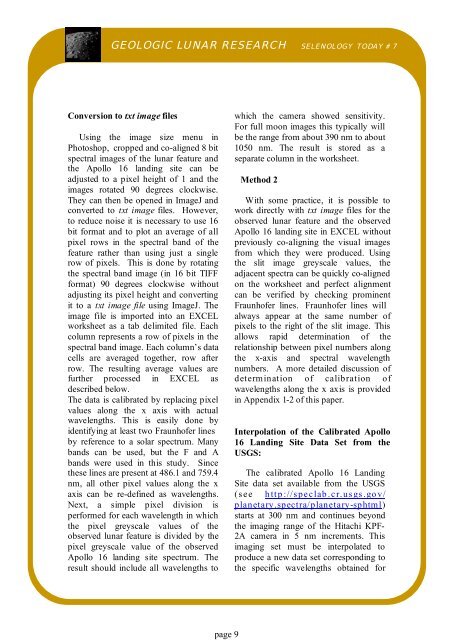Selenology Today # 7 July 2007 - Home
Selenology Today # 7 July 2007 - Home
Selenology Today # 7 July 2007 - Home
You also want an ePaper? Increase the reach of your titles
YUMPU automatically turns print PDFs into web optimized ePapers that Google loves.
GEOLOGIC LUNAR RESEARCH SELENOLOGY TODAY # 7<br />
Conversion to txt image files<br />
Using the image size menu in<br />
Photoshop, cropped and co-aligned 8 bit<br />
spectral images of the lunar feature and<br />
the Apollo 16 landing site can be<br />
adjusted to a pixel height of 1 and the<br />
images rotated 90 degrees clockwise.<br />
They can then be opened in ImageJ and<br />
converted to txt image files. However,<br />
to reduce noise it is necessary to use 16<br />
bit format and to plot an average of all<br />
pixel rows in the spectral band of the<br />
feature rather than using just a single<br />
row of pixels. This is done by rotating<br />
the spectral band image (in 16 bit TIFF<br />
format) 90 degrees clockwise without<br />
adjusting its pixel height and converting<br />
it to a txt image file using ImageJ. The<br />
image file is imported into an EXCEL<br />
worksheet as a tab delimited file. Each<br />
column represents a row of pixels in the<br />
spectral band image. Each column’s data<br />
cells are averaged together, row after<br />
row. The resulting average values are<br />
further processed in EXCEL as<br />
described below.<br />
The data is calibrated by replacing pixel<br />
values along the x axis with actual<br />
wavelengths. This is easily done by<br />
identifying at least two Fraunhofer lines<br />
by reference to a solar spectrum. Many<br />
bands can be used, but the F and A<br />
bands were used in this study. Since<br />
these lines are present at 486.1 and 759.4<br />
nm, all other pixel values along the x<br />
axis can be re-defined as wavelengths.<br />
Next, a simple pixel division is<br />
performed for each wavelength in which<br />
the pixel greyscale values of the<br />
observed lunar feature is divided by the<br />
pixel greyscale value of the observed<br />
Apollo 16 landing site spectrum. The<br />
result should include all wavelengths to<br />
page 9<br />
which the camera showed sensitivity.<br />
For full moon images this typically will<br />
be the range from about 390 nm to about<br />
1050 nm. The result is stored as a<br />
separate column in the worksheet.<br />
Method 2<br />
With some practice, it is possible to<br />
work directly with txt image files for the<br />
observed lunar feature and the observed<br />
Apollo 16 landing site in EXCEL without<br />
previously co-aligning the visual images<br />
from which they were produced. Using<br />
the slit image greyscale values, the<br />
adjacent spectra can be quickly co-aligned<br />
on the worksheet and perfect alignment<br />
can be verified by checking prominent<br />
Fraunhofer lines. Fraunhofer lines will<br />
always appear at the same number of<br />
pixels to the right of the slit image. This<br />
allows rapid determination of the<br />
relationship between pixel numbers along<br />
the x-axis and spectral wavelength<br />
numbers. A more detailed discussion of<br />
determination of calibration of<br />
wavelengths along the x axis is provided<br />
in Appendix 1-2 of this paper.<br />
Interpolation of the Calibrated Apollo<br />
16 Landing Site Data Set from the<br />
USGS:<br />
The calibrated Apollo 16 Landing<br />
Site data set available from the USGS<br />
(s ee h ttp ://s peclab .cr.us gs .go v/<br />
planetary.spectra/planetary-sphtml)<br />
starts at 300 nm and continues beyond<br />
the imaging range of the Hitachi KPF-<br />
2A camera in 5 nm increments. This<br />
imaging set must be interpolated to<br />
produce a new data set corresponding to<br />
the specific wavelengths obtained for


